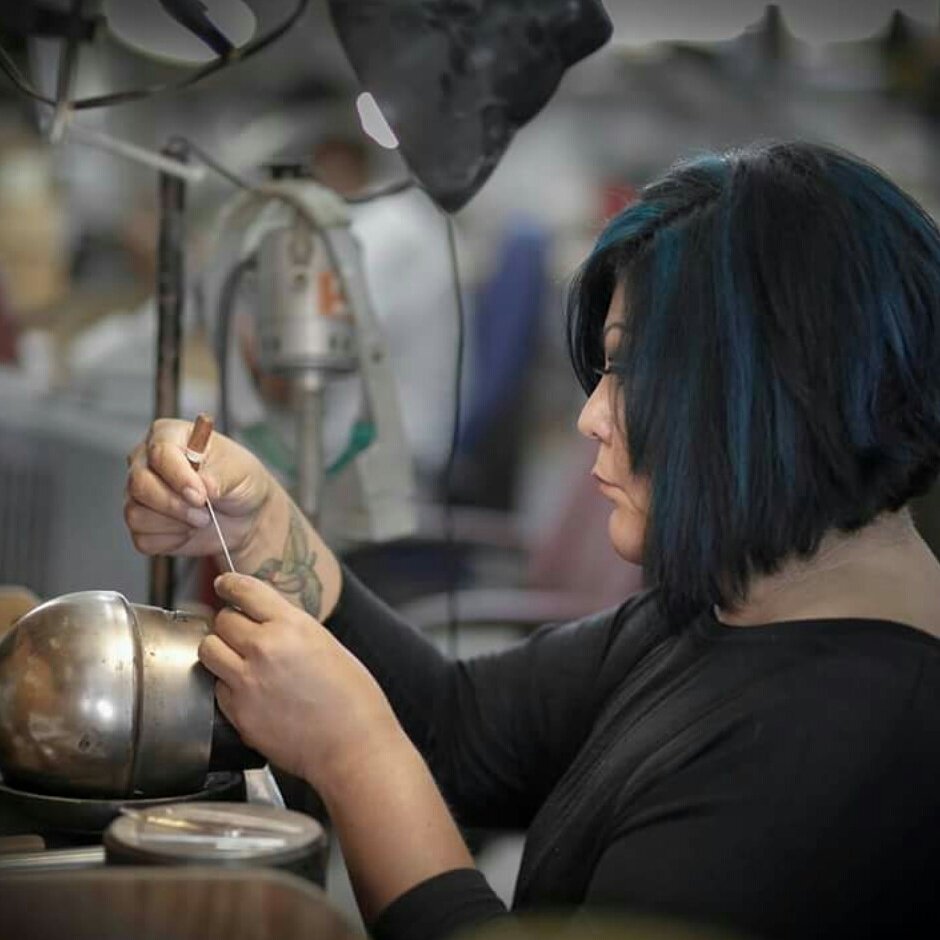
Continuing the tradition of fine jewelry making and blending modern technology with traditional aesthetics, it is our hope that our attention to detail and passion for creation come through in every piece made. As a father/daughter team, we are not only fortunate to spend time together doing what we love, but are also blessed to witness one another evolve in our art form.
Drawing from our culture and surroundings, from concept to execution of any given piece, our aim is to create wearable art that can be shared with the world.
-Michael & Elizabeth M. Kirk
Meet the Kirks
Both born and raised in Isleta Pueblo, their studio sits close to the reservation line near Bosque Farms, New Mexico, just twenty minutes south of Albuquerque. Michael started his jewelry career in 1971 after a tour in Vietnam. Elizabeth joined him in 1994, taking over the business aspect of the company, thus starting the never ending learning process of jewelry making. The duo are available by appointment only. Their work can be purchased in numerous museums and galleries worldwide or direct from the artists themselves. From Argentium Silver to Gold (14k-24k), precious to semi-precious stones, liquid ceramic to inlay, their combinations and design possibilities are endless.
Michael and Elizabeth's creations have been featured in both the New York and Washington, D.C. American Indian Museum galleries, as well as in the Smithsonian catalog. Nearly 30 years after her father originally started working with the Smithsonian, Elizabeth was able to re-establish her family's relationship with this institution, making their creations once again available to its large, international audience. Continuing to build upon the foundation laid so many years ago, she upholds the tradition of fine jewelry making, blending modern technology with traditional aesthetics. A second-generation jeweler, Elizabeth comes from a family of trailblazers in the Native American fine arts world. Her father, Michael Kirk, and her late uncle, Andy Lee Kirk, decided at the beginning of their careers to set themselves apart from other artists by using high karat gold and other materials considered nontraditional at the time. Today, they continue to incorporate materials and techniques not usually seen in Native American jewelry. Her groundbreaking work with the Kilar E-Coating system has allowed her to breathe new life into designs handed down over the years.
ABOUT THE PROCESS
In developing the color series, the whole allure was being able to add color without utilizing stone. To create the bright colors, we add a ceramic e-coat to the jewelry using electroplating technology. To my knowledge, there are only a handful of artists using this process; it is relatively new, and different, for most people to see. I love that these pieces incorporate the traditional part of jewelry which is the fabrication and the contemporary part which is the coloring.
The jewelry pieces are all handmade, fabricated pieces. The e-coating color system is the final step the pieces go through and it brings out and magnifies any imperfection. Extreme care must be taken in the finishing process. The coloring process involves eleven steps comprised of an electrocleaner, distilled water, an acid dip and drying done with an air compressor. Fingerprints will show up in the color so we can’t touch the pieces and have actually developed our own tools for handling the jewelry.
Once the piece is completely finished to our satisfaction, we submerge the jewelry in a liquid bath and apply electricity, choosing voltage based on the thickness of ceramic wanted on the piece and the color we want to achieve. The other factor that affects the color is how long you apply the electrical current. The color process is followed by more cleaning steps and drying. While it air dries, it goes from something that looks tacky to a very metallic finish. Finally the pieces are cured for 30 minutes in the oven, removed and allowed to cool. Depending on the look we are wanting to achieve more steps are involved, if multiple colors are placed a single piece can have a coloring process of 26+ steps.





